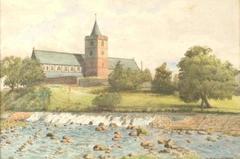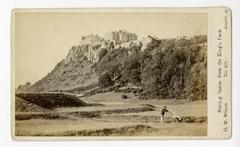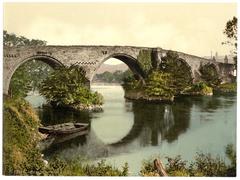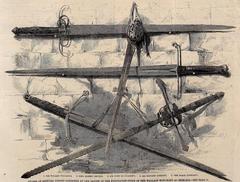
Walled Garden Stirling Visiting Hours Tickets and Historical Sites
Date: 24/07/2024
Introduction
The Walled Garden in Stirling, United Kingdom, is a serene haven that marries historical significance with horticultural beauty. These enclosed spaces, originating in ancient Persia and evolving through medieval Europe to their zenith in the 18th and 19th centuries, have long been cherished for their aesthetic and functional qualities (House & Garden). In Stirling, the Walled Garden offers visitors a glimpse into this rich heritage, featuring lush vegetation, intricate layouts, and historical artifacts that tell the story of its evolution. Whether you’re a history enthusiast, a nature lover, or simply seeking a peaceful retreat, the Walled Garden provides a unique experience that blends the past with the present. Visitors can explore a variety of plants, enjoy guided tours, and participate in special events, all while supporting local charities through the Scottish Gardens Scheme (Your Stirling). This comprehensive guide aims to provide essential information on visiting hours, tickets, travel tips, and nearby attractions to help you make the most of your visit.
History of the Walled Garden
Origins and Early Development
The concept of the walled garden dates back to ancient Persia, where these enclosed spaces were known as “pairidaeza,” meaning “enclosed place.” These gardens were designed as places of calm and reflection, often influenced by religious and philosophical ideals. The Persian walled gardens were characterized by their geometric layouts, water features, and lush plantings, creating a microcosm of paradise on earth (House & Garden).
Medieval and Renaissance Europe
During the Middle Ages, the idea of the walled garden spread to Europe, where it became known as the “hortus conclusus” or “enclosed garden.” These gardens were often associated with monasteries and were designed with an ecclesiastical approach, featuring straight lines, motifs, and an overriding sense of order. They served both practical and symbolic purposes, providing a space for growing medicinal herbs and vegetables while also representing the Virgin Mary and her body as a sacred, sealed space (Financial Times).
The 18th and 19th Centuries
The 18th and 19th centuries saw the height of popularity for walled gardens in the United Kingdom. These gardens were often part of large estates and were used to cultivate a wide variety of fruits, vegetables, and flowers. The walls provided a means of control, creating a clear demarcation between the cultivated and the wild. They also offered protection from the elements, trapping the heat of the sun to create a microclimate that assisted in the growth of plants (Financial Times).
One of the largest walled gardens of this period was Queen Victoria’s royal kitchen garden at Windsor, built in 1844, which spanned an enormous 31 acres. These gardens were meticulously managed by gardeners who worked closely with the household to fulfill its needs. An acre of a well-maintained walled garden could feed twelve people, and some gardens even reached up to 30 acres in size (House & Garden).
Technological Advancements
The introduction of greenhouses and the repeal of the glass tax in 1845 and window tax in 1851 further enhanced the utility of walled gardens. These advancements extended the growing season and allowed for the cultivation of exotic plants that would not have survived in the British climate. South-facing walls were often used to grow espaliered fruit trees, taking advantage of the additional warmth provided by the sun (House & Garden).
Decline and Resurgence
The popularity of walled gardens declined after the Second World War, as changes in social and economic conditions made them less practical. However, there has been a resurgence of interest in recent years, driven by a desire to reconnect with nature and promote sustainability. Many historical walled gardens have been restored and are now used to provide local produce for communities or catering for visitor cafés at estates (Financial Times).
Visitor Information
Visiting Hours and Tickets
When planning a visit, it’s essential to check the specific walled garden’s visiting hours and ticket prices. Many gardens offer seasonal hours, guided tours, and special events. For accurate and up-to-date information, visit the official websites of the gardens you plan to visit.
Travel Tips
- Plan Ahead: Some walled gardens require advance booking, especially during peak seasons.
- Accessibility: Check if the garden is wheelchair accessible and if there are any special accommodations available.
- Nearby Attractions: Combine your visit with nearby historical sites or other attractions to make the most of your trip.
- Photography: Many walled gardens have designated photo spots, making them perfect for capturing beautiful memories.
Notable Examples
Croome Court, Worcestershire
The walled kitchen garden at Croome Court in Worcestershire is reputedly the largest 18th-century walled kitchen garden in Europe. It features a historically significant 13-foot high free-standing hot wall built around 1806, serviced by five furnaces. This structure was one of the first of its kind and played a crucial role in extending the growing season for various plants (Wikipedia).
Chilton Foliat, Wiltshire
The walled garden at Chilton Foliat in Wiltshire gained fame through the 1987 television documentary series “The Victorian Kitchen Garden.” This series highlighted the historical significance and the intricate management of such gardens during the Victorian era (Wikipedia).
Cresswell Pele Tower
The walled garden at Cresswell Pele Tower received a £230,000 grant from the National Lottery Heritage Fund in July 2022 for its restoration. This garden, once a six-acre kitchen garden providing for the Baker-Cresswell family and their estate workers, is being transformed into a community garden with accessible paths, a greenhouse, a wildlife-friendly pond, and an events pavilion. The project also includes the planting of dozens of fruit trees to recreate a traditional orchard and the installation of bee hives (Cresswell Pele Tower).
Literary and Cultural Significance
Walled gardens have also found a place in literature and culture. In John William Waterhouse’s interpretation of the myth of Cupid and Psyche, Psyche lived in Cupid’s walled garden. Similarly, Frances Hodgson Burnett’s “The Secret Garden” (1911) features a young protagonist who reawakens an old walled garden, symbolizing personal growth and rejuvenation. The walled garden serves as a metaphor for the protagonist’s journey, nurturing her as she nurtures it back to life (Financial Times).
Conclusion
The history of walled gardens showcases human ingenuity and the timeless desire to create harmonious spaces where nature and creativity intertwine. Whether you’re a history enthusiast, a garden lover, or simply seeking a peaceful retreat, walled gardens offer something for everyone. Don’t forget to check the visiting hours and ticket prices before planning your visit. Download our app Audiala for more updates and exclusive content, and follow us on social media to stay informed about the latest attractions.
FAQ
Q: What are the typical visiting hours for walled gardens? A: Visiting hours vary by location and season. It’s best to check the specific garden’s official website for the most accurate information.
Q: How much do tickets to walled gardens usually cost? A: Ticket prices can range from free entry to a fee, depending on the garden and any special events or tours offered. Check the official websites for up-to-date pricing.
Q: Are walled gardens accessible for wheelchair users? A: Many walled gardens offer wheelchair accessibility, but it’s advisable to check in advance for specific accommodations.
Q: Can I take photographs in walled gardens? A: Most walled gardens allow photography and even have designated spots for capturing beautiful images. Always check the garden’s photography policy beforehand.
Q: What are the best times to visit a walled garden? A: The best times to visit walled gardens are typically during spring and summer when the gardens are in full bloom. Some gardens also offer special events during these seasons that are worth checking out.
Q: Do walled gardens offer guided tours? A: Many walled gardens offer guided tours that provide insight into their history and horticulture. It’s best to check the specific garden’s website for tour schedules and availability.
References
- House & Garden. (n.d.). The history and design of walled gardens. Retrieved from https://www.houseandgarden.co.uk/article/walled-garden-wall-ideas
- Financial Times. (n.d.). The history of walled gardens. Retrieved from https://propertylistings.ft.com/propertynews/united-kingdom/7284-wall-encompassing-a-short-history-of-the-walled-garden.html
- Your Stirling. (n.d.). Charity garden opening - Gardener’s Cottage Walled Garden. Retrieved from https://www.yourstirling.com/dt/2321535/charity-garden-opening-gardeners-cottage-walled-garden/








